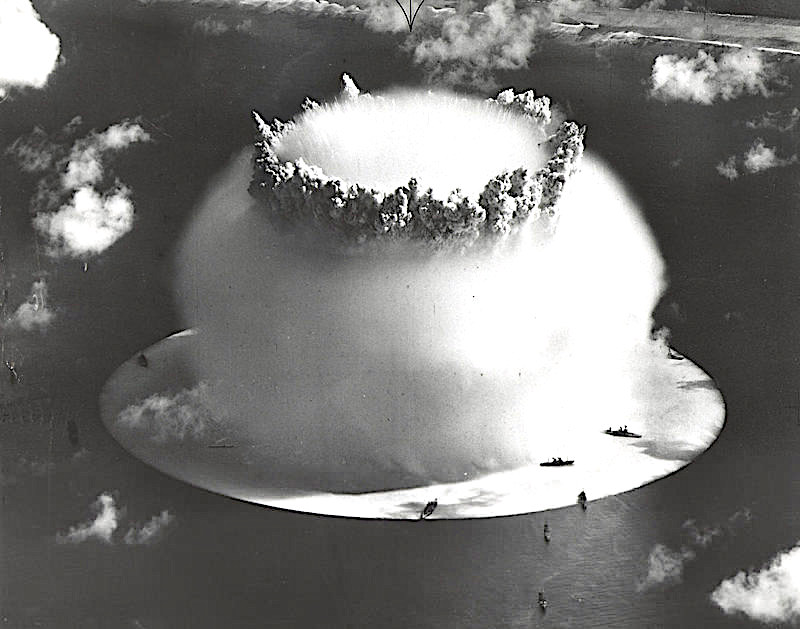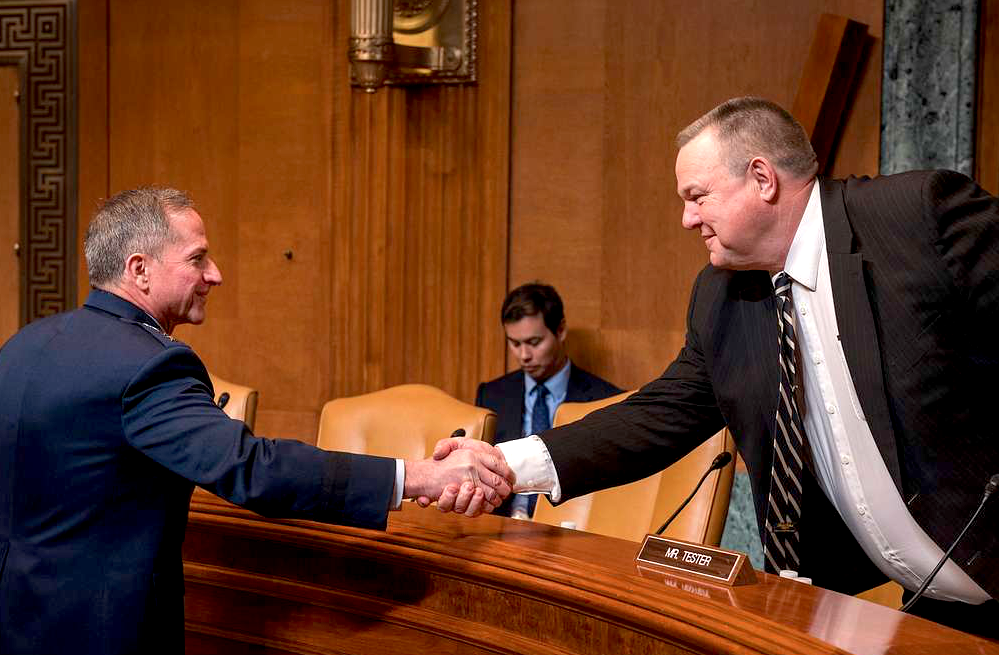Private contractors run the nuclear warhead complex and build nuclear delivery vehicles. To keep the gravy train running, those contractors spend millions lobbying decision-makers, writes William D. Hartung.

Old Watchtower at the former east gate of Los Alamos National Laboratory, New Mexico. (Daniel Schwen, Wikimedia Commons, CC BY-SA 4.0)
By William D. Hartung
TomDispatch.com
 Unless you’ve been hiding under a rock for the past few months, you’re undoubtedly aware that award-winning director Christopher Nolan has released a new film about Robert Oppenheimer, known as the “father of the atomic bomb” for leading the group of scientists who created that deadly weapon as part of America’s World War II-era Manhattan Project.
Unless you’ve been hiding under a rock for the past few months, you’re undoubtedly aware that award-winning director Christopher Nolan has released a new film about Robert Oppenheimer, known as the “father of the atomic bomb” for leading the group of scientists who created that deadly weapon as part of America’s World War II-era Manhattan Project.
The film has earned widespread attention, with large numbers of people participating in what’s already become known as “Barbieheimer” by seeing Greta Gerwig’s film Barbie and Nolan’s three-hour-long Oppenheimer on the same day.
Nolan’s film is a distinctive pop cultural phenomenon because it deals with the American use of nuclear weapons, a genuine rarity since ABC’s 1983 airing of “The Day After” about the consequences of nuclear war. (An earlier exception was Stanley Kubrick’s Dr. Strangelove, his satirical portrayal of the insanity of the Cold War nuclear arms race.)
The film is based on American Prometheus, the Pulitzer Prize-winning 2005 biography of Oppenheimer by Kai Bird and Martin Sherwin.
Nolan made it in part to break through the shield of antiseptic rhetoric, bloodless philosophizing, and public complacency that has allowed such world-ending weaponry to persist so long after Trinity, the first nuclear bomb test, was conducted in the New Mexico desert 78 years ago this month.
 Nolan’s impetus was rooted in his early exposure to the nuclear disarmament movement in Europe. As he said recently:
Nolan’s impetus was rooted in his early exposure to the nuclear disarmament movement in Europe. As he said recently:
“It’s something that’s been on my radar for a number of years. I was a teenager in the ‘80s, the early ‘80s in England. It was the peak of CND, Campaign for Nuclear Disarmament, the Greenham Common [protest]; the threat of nuclear war was when I was 12, 13, 14 — it was the biggest fear we all had. I think I first encountered Oppenheimer in … Sting’s song about the Russians that came out then and talks about Oppenheimer’s ‘deadly toys.’”
A feature film on the genesis of nuclear weapons may not strike you as an obvious candidate for box-office blockbuster status.
As Nolan’s teenage son said when his father told him he was thinking about making such a film, “Well, nobody really worries about nuclear weapons anymore. Are people going to be interested in that?”
Nolan responded that, given what’s at stake, he worries about complacency and even denial when it comes to the global risks posed by the nuclear arsenals on this planet.
“You’re normalizing killing tens of thousands of people. You’re creating moral equivalences, false equivalences with other types of conflict… [and so] accepting, normalizing… the danger.”
These days, unfortunately, you’re talking about anything but just tens of thousands of people dying in a nuclear face-off. A 2022 report by Ira Helfand and International Physicians for the Prevention of Nuclear War estimated that a “limited” nuclear war between India and Pakistan that used roughly 3 percent of the world’s 12,000-plus nuclear warheads would kill “hundreds of millions, perhaps even billions” of us.
A full-scale nuclear war between the United States and Russia, the study suggests, could kill up to 5 (yes, 5!) billion people within two years, essentially ending life as we know it on this planet in a “nuclear winter.”
Obviously, all too many of us don’t grasp the stakes involved in a nuclear conflict, thanks in part to “psychic numbing,” a concept regularly invoked by Robert Jay Lifton, co-author with Greg Mithchell of Hiroshima in America: A History of Denial, among many other books. Lifton describes psychic numbing as “a diminished capacity or inclination to feel” prompted by “the completely unprecedented dimension of this revolution in technological destructiveness.”
Given the Nolan film’s focus on Oppenheimer’s story, some crucial issues related to the world’s nuclear dilemma are either dealt with only briefly, or omitted altogether.

Christopher Nolan during the making of the 2017 movie “Dunkirk.” (HellaCinema, Wikimedia Commons, CC BY-SA 4.0)
The staggering devastation caused by the bombings of Hiroshima and Nagasaki is suggested only indirectly without any striking visual evidence of the devastating human consequences of the use of those two weapons.
Also largely ignored are the critical voices who then argued that there was no need to drop a bomb, no less two of them, on a Japan most of whose cities had already been devastated by U.S. fire-bombing to end the war.
General (and later President) Dwight D. Eisenhower wrote when he was told by Secretary of War Henry Stimson of the plan to drop atomic bombs on populated areas in Japan:
“I voiced to him my grave misgivings, first on the basis of my belief that Japan was already defeated and that dropping the bomb was completely unnecessary.”
Nor does the film address the health impacts of the research, testing, and production of such weaponry, which to this day is still causing disease and death, even without another nuclear weapon ever being used in war.
[Related: Start of a New World War]
Victims of nuclear weapons development include people who were impacted by the fallout from U.S. nuclear testing in the western United States and the Marshall Islands in the Western Pacific, uranium miners on Navajo lands, and many others.

“Event Baker,” a 21-kiloton underwater nuclear-weapons-effects test at Bikini Atoll in the Marshall Islands in 1946; showing the white surface “crack” under the ships and the top of the hollow spray column protruding through the hemispherical Wilson cloud. Bikini Island beach in the background. (U.S. Army Photographic Signal Corps, Wikimedia Commons, Public domain)
Speaking of the first nuclear test in Los Alamos, New Mexico, Tina Cordova of the Tularosa Basin Downwinders Consortium, which represents that state’s residents who suffered widespread cancers and high rates of infant mortality caused by radiation from that explosion, said, “It’s an inconvenient truth … People just don’t want to reflect on the fact that American citizens were bombed at Trinity.”
Another crucially important issue has received almost no attention. Neither the film nor the discussion sparked by it has explored one of the most important reasons for the continued existence of nuclear weapons — the profits it yields the participants in America’s massive nuclear-industrial complex.
Once Oppenheimer and other concerned scientists and policymakers failed to convince the Truman administration to simply close Los Alamos and place nuclear weapons and the materials needed to develop them under international control — the only way, as they saw it, to head off a nuclear arms race with the Soviet Union — the drive to expand the nuclear weapons complex was on.
Research and production of nuclear warheads and nuclear-armed bombers, missiles, and submarines quickly became a big business, whose beneficiaries have worked doggedly to limit any efforts at the reduction or elimination of nuclear arms.
Birth of the Nuclear-Industrial Complex
 The Manhattan Project Oppenheimer directed was one of the largest public works efforts ever undertaken in American history.
The Manhattan Project Oppenheimer directed was one of the largest public works efforts ever undertaken in American history.
Though the Oppenheimer film focuses on Los Alamos, it quickly came to include far-flung facilities across the United States.
At its peak, the project would employ 130,000 workers — as many as in the entire U.S. auto industry at the time.
According to nuclear expert Stephen Schwartz, author of Atomic Audit, the seminal work on the financing of U.S. nuclear weapons programs, through the end of 1945 the Manhattan Project cost nearly $38 billion in today’s dollars, while helping spawn an enterprise that has since cost taxpayers an almost unimaginable $12 trillion for nuclear weapons and related programs.
And the costs never end.
The Nobel prize-winning International Campaign to Abolish Nuclear Weapons (ICAN) reports that the U.S. spent $43.7 billion on nuclear weapons last year alone, and a new Congressional Budget Office report suggests that another $756 billion will go into those deadly armaments in the next decade.
Private contractors now run the nuclear warhead complex and build nuclear delivery vehicles.
They range from Raytheon, General Dynamics, and Lockheed Martin to lesser-known firms like BWX Technologies and Jacobs Solutions, all of which split billions of dollars in contracts from the Pentagon (for the production of nuclear delivery vehicles) and the Department of Energy (for nuclear warheads).
To keep the gravy train running — ideally, in perpetuity — those contractors also spend millions lobbying decision-makers. Even universities have gotten into the act. Both the University of California and Texas A&M are part of the consortium that runs the Los Alamos nuclear weapons laboratory.
The American warhead complex is a vast enterprise with major facilities in California, Missouri, Nevada, New Mexico, South Carolina, Tennessee and Texas. And nuclear-armed submarines, bombers, and missiles are produced or based in California, Connecticut, Georgia, Louisiana, North Dakota, Montana, Virginia, Washington State and Wyoming.
Add in nuclear subcontractors and most states host at least some nuclear-weapons-related activities.
And such beneficiaries of the nuclear weapons industry are far from silent when it comes to debating the future of nuclear spending and policy-making.
The Nuclear Weapons Lobby

Jacob Solutions’ headquarters in Dallas. (Shaggylawn65, Wikimedia Commons, CC BY-SA 4.0)
The institutions and companies that build nuclear bombs, missiles, aircraft, and submarines, along with their allies in Congress, have played a disproportionate role in shaping U.S. nuclear policy and spending.
They have typically opposed the U.S. ratification of a Comprehensive Nuclear Test Ban Treaty; put strict limits on the ability of Congress to reduce either funding for or the deployment of intercontinental ballistic missiles (ICBMs); and pushed for weaponry like a proposed nuclear-armed, sea-launched cruise missile that even the Pentagon hasn’t requested, while funding think tanks that promote an ever more robust nuclear weapons force.
A case in point is the Senate ICBM Coalition (dubbed part of the “Dr. Strangelove Caucus” by Arms Control Association Director Daryl Kimball and other critics of nuclear arms). The ICBM Coalition consists of senators from states with major ICBM bases or ICBM research, maintenance, and production sites: Montana, North Dakota, Utah, and Wyoming.
The sole Democrat in the group, Jon Tester (D-MT), is the chair of the powerful appropriations subcommittee of the Senate Appropriations Committee, where he can keep an eye on ICBM spending and advocate for it as needed.
The Senate ICBM Coalition is responsible for numerous measures aimed at protecting both the funding and deployment of such deadly missiles. According to former Secretary of Defense William Perry, they are among “the most dangerous weapons we have” because a president, if warned of a possible nuclear attack on this country, would have just minutes to decide to launch them, risking a nuclear conflict based on a false alarm.
That Coalition’s efforts are supplemented by persistent lobbying from a series of local coalitions of business and political leaders in those ICBM states. Most of them work closely with Northrop Grumman, the prime contractor for the new ICBM, dubbed the Sentinel and expected to cost at least $264 billion to develop, build, and maintain over its life span that is expected to exceed 60 years.

Mar. 13, 2019: Gen. David Goldfein, then Air Force chief of staff, is greeted by Tester before testifying at Senate Appropriations Committee hearing on Air Force funding. (U.S. Air Force, Adrian Cadiz)
Of course, Northrop Grumman and its 12 major ICBM subcontractors have been busy pushing the Sentinel as well. They spend tens of millions of dollars on campaign contributions and lobbying annually, while employing former members of the government’s nuclear establishment to make their case to Congress and the executive branch.
And those are hardly the only organizations or networks devoted to sustaining the nuclear arms race. You would have to include the Air Force Association and the obscurely named Submarine Industrial Base Council, among others.
The biggest point of leverage the nuclear weapons industry and the arms sector more broadly have over Congress is jobs. How strange then that the arms industry has generated diminishing job returns since the end of the Cold War. According to the National Defense Industrial Association, direct employment in the weapons industry has dropped from 3.2 million in the mid-1980s to about 1.1 million today.
Even a relatively small slice of the Pentagon and Department of Energy nuclear budgets could create many more jobs if invested in green energy, sustainable infrastructure, education, or public health – anywhere from 9 percent to 250 percent more jobs, depending on the amount spent.
Given that the climate crisis is already well underway, such a shift would not only make this country more prosperous but the world safer by slowing the pace of climate-driven catastrophes and offering at least some protection against its worst manifestations.
A New Nuclear Reckoning?

Protest in Amsterdam against the nuclear arms race between U.S.-NATO and the Soviet Union, 1981. (Rob Bogaerts, Anefo, Wikimedia Commons, CC0)
Count on one thing: by itself, a movie focused on the origin of nuclear weapons, no matter how powerful, won’t force a new reckoning with the costs and consequences of America’s continued addiction to them. But a wide variety of peace, arms-control, health, and public-policy-focused groups are already building on the attention garnered by the film to engage in a public education campaign aimed at reviving a movement to control and eventually eliminate the nuclear danger.
Past experience — from the Campaign for Nuclear Disarmament that helped persuade Christopher Nolan to make “Oppenheimer” to the “Ban the Bomb” and Nuclear Freeze campaigns that stopped above-ground nuclear testing and helped turn President Ronald Reagan around on the nuclear issue — suggests that, given concerted public pressure, progress can be made on reining in the nuclear threat.
The public education effort surrounding the Oppenheimer film is being taken up by groups like The Bulletin of the Atomic Scientists, the Federation of American Scientists and the Council for a Livable World that were founded, at least in part, by Manhattan Project scientists who devoted their lives to trying to roll back the nuclear arms race; professional groups like the Union of Concerned Scientists and Physicians for Social Responsibility; anti-war groups like Peace Action and Win Without War; the Nobel Peace prize-winning International Campaign to Abolish Nuclear Weapons; nuclear policy groups like Global Zero and the Arms Control Association; advocates for Marshall Islanders, “downwinders,” and other victims of the nuclear complex; and faith-based groups like the Friends Committee on National Legislation.
The Native American–led organization Tewa Women United has created a website, “Oppenheimer — and the Other Side of the Story,” that focuses on “the Indigenous and land-based peoples who were displaced from our homelands, the poisoning and contamination of sacred lands and waters that continues to this day, and the ongoing devastating impact of nuclear colonization on our lives and livelihoods.”
[Related: The Movie & the Moment to Stop Nuclear Rearmament]
On the global level, the 2021 entry into force of a nuclear ban treaty — officially known as the Treaty on the Prohibition of Nuclear Weapons — is a sign of hope, even if the nuclear weapons states have yet to join. The very existence of such a treaty does at least help delegitimize nuclear weaponry. It has prompted dozens of major financial institutions to stop investing in the nuclear weapons industry, under pressure from campaigns like Don’t Bank on the Bomb.
In truth, the situation couldn’t be simpler: we need to abolish nuclear weapons before they abolish us. Hopefully, “Oppenheimer” will help prepare the ground for progress in that all too essential undertaking, beginning with a frank discussion of what’s now at stake.
William D. Hartung, a TomDispatch regular, is the director of the Arms and Security Program at the Center for International Policy and the author, with Elias Yousif, of U.S. Arms Sales Trends 2020 and Beyond: From Trump to Biden.
This article is from TomDispatch.com.
The views expressed are solely those of the author and may or may not reflect those of Consortium News.
.

Destructiveness: pays. Constructivness: doesn’t.
“Lifton describes psychic numbing as “a diminished capacity or inclination to feel” prompted by “the completely unprecedented dimension of this revolution in technological destructiveness.”
This “psychic numbing” concept is helpful to getting clear on what is happening, including beyond the horror of acknowledging what happened at Hiroshima and Nagasaki, and being bandied about at this time relative to the Ukraine war’s expansion. Even “horror” is now an inadequate, over-used word. “Diminished capacity or inclination to feel”–now we’re getting somewhere, especially with “diminished . . . inclination to feel.”
A narrative approach to official reality (and a robust economy) demands psychic numbing, which is being put to use very effectively as a way of massaging and managing national consciousness suitable to controlling the populace, that long-sought goal. Back 50 years ago that narrative re the cruelty and lunacy of dropping these bombs on innocents in Japan was that they were still capable of fighting back; had to do it, no other possibility, sorry.
“Psychic numbing” is at work widely today, from advertising for innumerable products on TV, including, for example, dangerously toxic drugs each with its long list of side-effects simultaneously displayed with smiling actors for Big Pharma. A hedonistic way of life, emphasizing unreal expectations for limitless freedom and self-indulgence, dominates the society. We’re looking at diminished inclination to feel . . . or think.
We human beings appear to be determined to drive ourselves into extinction and to destroy as much of the environment as we can in the process.
There should not even be a profit motive in nuclear weapons development and the arms industry itself. The waste of money on lobbying by them too.
I am glad the details of the horror we are getting into are being published. Perhaps there is a glimmer of hope that life on this planet will survive. Please continue your work. I am not a scientist, am 80 years old, but will help wherever I can. I live in Happy Valley, a suburb of Portland, Oregon.
The movie is not well designed for the thinking person. There are blasts of noise, representing explosions that are often flashbacks in the mind of Oppenheimer, perhaps in his dreams. Scenes jump backwards and forwards in time so that mental space for reasoning is pre-empted by mental space devoted to sorting out chronologies. Background music sometimes has the noise level increase just as key words are spoken, making it harder to understand the words. From what I gathered the primary aim was to create the trappings and mood of conflict of minds and internal conflicts, rather than serious, sustained thinking. (I recall Adlai Stevenson’s reported reply to an enthusiastic supporter during a campaign rally: “Every thinking American will vote for you.” Adlai: “I’m afraid that’s not enough for me to win.”)
I would bemoan the plug for cigarettes as Oppenheimer is shown smoking cigarettes (or pipe) almost constantly throughout. It reminded me how useful to tobacco interests Humphrey Bogart movies were in the 1930s. However, Wikipedia reports that Oppenheimer smoked 100 cigarettes a day, so there may be some justification.
I would guess that the tobacco industry killed many more people in the U.S. in 1945 than the nuclear bombs killed in Japan that year. I recall eating “C” rations fighting Alaskan forest fires in the late 1950s. These were U.S.combat rations, supplied by the Bureau of Land Management. There was always a pack of cigarettes inside. War was a good way of hooking young men. Maybe this imagery of nuclear war and Oppenheimer smoking will unfortunately renew the symbiosis.
Critics have rightly noted the lack of pictures showing the horrible sufferings of people who survived the blast only to live for days or weeks in agony from the radiation effects. The other lack related to the effect the blast had on native and other people in New Mexico.
Soft-pedalling the harms is the opposite of what is needed when the spectre of nuclear war has become alive again in our time.
What’s good is that Oppenheimer himself foresaw that other nations would engage in an arms race and that he warned the U.S. to insist on having enforceable international controls to stop this. What’s bad is that his advice went unheeded.
What’s also bad about the movie is that it has a lot of flag-waving reminiscent of Trump’s campaign, and that Oppenheimer is made an acceptable hero only because he was found, upon investigation, to be a “loyal American.” Why can’t you be a loyal American if you do your best to resist the overblown , lying, pseudo-patriotic forces bent on world domination who have no hesitation in destroying opponents such as Oppenheimer. In the movie, the system vindicated Oppenheimer with the help of his powerful friends. In reality, there are those like Julian Assange, not a U.S. citizen, who provided the light needed to help the U.S. engage in necessary reforms. The movie is no help for people like him.
Thankyou Randal for that informative opinion. Your last paragraph really rings true. So now i think i’ll pass on going to see it.
It seems that you would have preferred a flat documentary aimed at those non-thinking people who have managed to remain oblivious over the past 7 decades to the horrors of nuclear weapons (and political smears and smoking, just to toss in another couple of topics worthy of a documentary) rather than at thinking people who may not have acquainted themselves with the details of the effects on those who created them. Perhaps the title of the film might have given you an advance clue.
“The film has earned widespread attention, with large numbers of people participating in what’s already become known as “Barbieheimer” by seeing Greta Gerwig’s film Barbie and Nolan’s three-hour-long Oppenheimer on the same day.”
That about says it all about the dialectical underpinnings of a society in collapse.
The Pentagon can be surprisingly sensitive to public opinion.
The protests against the resumption of nuclear testing by France in 1995 killed off the very real danger that the US would follow suit. In addition, the Pentagon also agreed to abandon any idea of allowing nuclear tests up to a yield of 1KT under the test ban treaty then under negotiation. I can well remember a senior military officer at a press conference where he also endorsed the plan to lower the test readiness of the nuclear test site in Nevada.
The situation today is very dangerous but, as past protests have shown, we can reverse this if we do something about it.
I hope that people will make that choice.
Thank you.